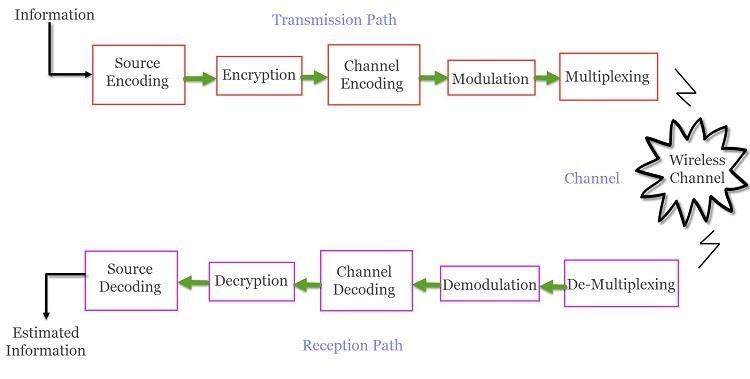Wireless Communication Solutions: The Technology, Market, and Implementation


Today, when the modern economy is driven by technological advancement, the wireless communication solution market is the answer to the evolving consumer and industry needs. In this rapidly growing sector, wireless solution development plays a significant role, offering innovative and efficient solutions to meet these ever-changing demands. Wireless communication itself implies the transfer of information between two or more points without a physical connection. The most popular wireless communication equipment includes cellular phones, GPS, wireless networking, radio receivers, satellite televisions, personal digital assistants, and more.
The growing usage of smart devices is one of the reasons why the global wireless communication solutions market is boosting. The market is forecasted to expand in value from $794.6 million in 2018 to $1867.8 million by 2023, at a CAGR of 18.6%. Overall, the sector is revolutionizing data exchange, communication, and transactions introducing the new digital economy.
This article takes a look at the general situation in the modern wireless technologies market, overviews the technological aspects, and offers some pieces of implementation advice.
GLOBAL MARKET DYNAMICS
After getting a general picture of the wireless communication network solutions market, we can examine the major market parameters.
Drivers
The altering consumer needs created a serious demand for a strong network, which led to the expansion of such services as 3G and 4G networks. Along with the high-performance smartphones and new operating systems, the rising social media awareness and the development of internet marketing are fueling the wireless communication solutions market.
Another important driver for wireless technology adoption in IoT implementation. The development of wireless IoT communications is projected to increase the number of connected devices. Besides, engineers keep creating solutions for Bluetooth, NFC/RFID, sensors, embedded wireless devices, and other technologies.
Opportunities
Wireless devices are considered game-changers in the industry. Their implementation helps improve the network, connect people, and conduct data surfing easily. The technology provides numerous opportunities for all players including manufacturers, engineers, wireless technology solutions providers, and, of course, consumers.
Restraints
The technical issues and poor infrastructure may pose challenges to the market growth. Another significant concern of a wireless system is data security. As the technology is based on transmitting the signal in an open space, an offender can potentially intercept the signal and access sensitive information. We, at Sirin Software, developed a number of recommendations on how to ensure the security of your business information.
ADVANTAGES OF WIRELESS COMMUNICATION SYSTEMS
- Reduced cost.
With wireless communications technologies, you are relieved from the cost of installing the infrastructure such as wires and cables. You also significantly save time, as you don’t need to lay the cables or run the wires.
- Mobility.
Mobility is the main upside of a wireless system. It offers the freedom to move while remaining connected.
- Easy installation.
The installation and setup of the network’s equipment and infrastructure are exceptionally easy, especially if you have the right wireless solution provider.
- Reliability.
Since no wires and cables are involved, your wireless system won’t fail due to the damage of these components.
- Disaster recovery.
Wireless communication systems minimize the loss of communication infrastructure caused by such accidents as fire, floods, and other disasters.
BASIC ELEMENTS OF WIRELESS COMMUNICATION TECHNOLOGIES
A wireless communication system typically consists of three elements: the transmitter, the channel, and the receiver, as shown in the block diagram below.

- The Transmission Path.
A transmission path usually comprises encoder, encryption, modulation, and multiplexing. The signal from the source comes to a source encoder that converts the signal for applying signal processing techniques. Then, the signal is encrypted for security purposes.
Channel encoding is applied to reduce the impairments like noise and interference. Then the signal is modulated with an appropriate modulation technique, such as PSK, FSK, and more. Thus, the signal becomes easy to transmit using the antenna.
After the modulation, the signal is multiplexed with other signals by means of different multiplexing techniques to share the valuable bandwidth.
- The Channel.
The channel here indicates the medium of signal transmission, which is open space. In its nature, a wireless channel is highly variable and random, which makes it subject to interference, noise, and distortion. As a result, the received signal may contain errors.
- The Reception Path.
The receiver is aimed to collect the signal from the channel and reproduce it as the initial signal. The reception path is exactly the opposite of the transmission path and aimed to get the initial transmitted message or signal back.
HOW DO I MAXIMIZE THE BENEFITS FROM WIRELESS TECHNOLOGY?
Although they have limitations, wireless technologies are very powerful when properly applied. Consider the following factors before implementing wireless devices:
- The availability of power.
Since wireless signals require little power, you can monitor the availability of power in remote regions. The sensor used in these applications also must operate on low power. Such sensors can run on inexpensive AA batteries. If the other source of power such as solar is used remotely, any type of sensor will suit.
- The response speed you need.
If the power is available, you can keep the sensor and wireless transmitter on, thus obtaining minimal response time. If there is no power available, you should measure the desired response time against the available battery life.
- The required wireless range.
There are wireless communication network solutions that can transmit across an entire large factory. If you select a long-range system, it will simplify the design by removing repeaters.
What happens in case of a wireless link failure?
The proper wireless solution provider will create a very reliable wireless system. However, the system should be designed to go down gracefully. If the link fails, the outputs should automatically return to a predefined state.
WRAPPING UP
Like with many other modern techs, the implementation of a wireless communication solution requires a wise approach. Start with identifying your specific purposes and weighing the benefits of technology adoption. Then, make leverage the expertise of proficient wireless technology solutions providers. This way, you will manage to maximize the advantages while eliminating the risks.
With our vast experience in wireless communication network solutions in general and wireless IoT communications in particular, we can help you with projects of any complexity. Consult the experts and determine your optimal wireless communication solution. Read our case study “Low-Power Active Distributed Antenna Network”.